Lion850
National Hazard
   
Posts: 514
Registered: 7-10-2019
Location: Australia
Member Is Offline
Mood: Great
|
|
Report on making a Bismuth nitrate & thiourea salt
Nitratopentakis-tiokarbamatbismuth(III) nitrate is mentioned on a crystal growing site:
https://en.m.crystalls.info/Nitratopentakis-tiokarbamatbismuth(III)_nitrate
The given equation for the reaction is:
Bi(NO3)3 + 5CS(NH2)2 = [Bi(NO3)(CS(NH2)2)5](NO3)2
The procedure given is simply: “For preparation of 100.00g of nitratopentakis-tiokarbamatbismuth(III) nitrate monohydrate а 61.12g of bismuth(III)
nitrate pentahydrate and 47.96g of thiourea is required. Add to the flask with thiourea solution a bismuth(III) nitrate solution with stirring. After
reaction will stop, filter the solution and use it for crystal growing.”
I was a bit confused as to whether the bismuth nitrate solution should be in very dilute nitric acid, to avoid hydrolysis to an insoluble basic
nitrate. I spent quite some time trying to find a more detailed procedure online with little luck (but did come across many other interesting bits of
information). One being that bismuth complex salts are sometimes made using methanol or acetone or ethanol as a solvent. I decided to try water first,
and to add the bismuth nitrate in solid form to the thiourea solution.
- 15.7g thiourea was dissolved in 100g water. It dissolved to a clear solution much easier than I expected; maybe I could have used less water.
- 20.1g of bismuth nitrate pentahydrate crystals was added in small portions with magnetic stirring. The solution turned orange even with the first
addition.
- After some 15 minutes stirring with all bismuth added the solution was opaque and looked like orange juice.
- When stirring was stopped the supernatant solution was red with a yellow ppt.
- Apply gentle heat to see if the ppt will dissolve, but the solution suddenly turned a chocolate color.
- Gravity filter twice. A little bit of black remainder, with red filtrate. Photo of filtrate below.
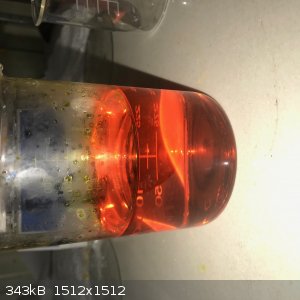
- Test some of the black remainder with conc. HCl, seems no reaction.
- Heat up a small portion of the red filtrate to see if it can be boiled down, but at a certain temperature it seems to start decomposing yielding the
black ppt.
- Next morning, pour the red solution into a shallow plastic dish and place in the (hot) Aussie sun. By the end of the day the volume had decreased
quite a bit and there seemed to be yellow crystals settling out in the center area of the dish. See photo below.
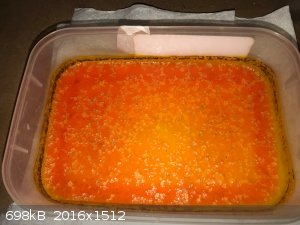
- After another day of sun drying, scratch out the yellow dryer crystals and red wetter crystals into separate crucibles. See photo below.
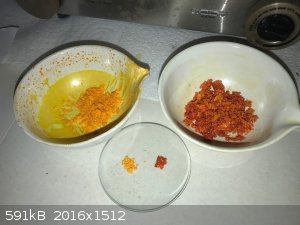
- Put a tiny piece of each color salt in a small crucible and on a steam bath. The yellow salt very soon decomposed at a very fast rate giving a white
smoke cloud of surprisingly large volume for the small sample and leaving black residue. At that point the red salt was just bubbling away. See photo
below of the aftermath.
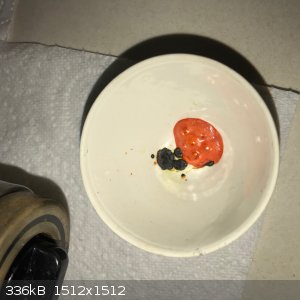
- Continued to dry both crucibles in the sun. After another 2 days the yellow was starting to become more orange and it was quite dry. I decided to
bottle it; I was a bit worried it may be sensitive if bone dry. 3.1g of yellow-orange crystals was bottled, see below. I called this the first crop as
it seemed to crystalise before the more red crystals.
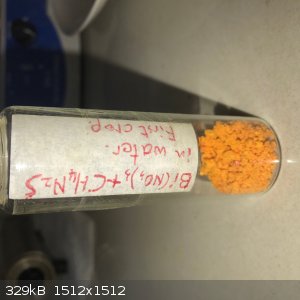
- The “red” crystals seemed to be a hydrate with a low melting point. In the morning it is a wet solid, but in the hot sun in a steel dish it
melts and very slowly bubbles. See photo below. I’m not sure if it absorbs moisture again at night when cooler as overall it did not seem to be
getting drier.
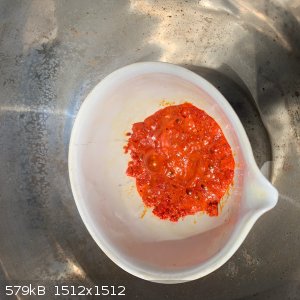
- Place red crystals in a desiccator under high vacuum and over NaOH for 36 hours. After 36 hours it seemed much drier, and the color was a bit less
bright. It was now a stiff, sticky paste that could be sliced into smaller pieces. See photos below of the final product, 12g was recovered.
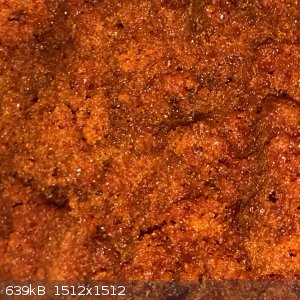 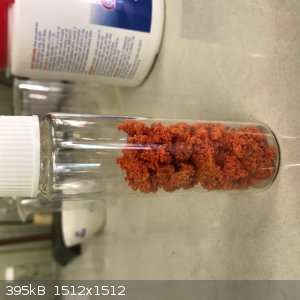
Whether at least one of these salts is “Nitratopentakis-tiokarbamatbismuth(III)” I don’t know; your opinions / assistance will be appreciated.
Is it worth repeating the experiment in dilute nitric acid?
|
|
|
Bedlasky
International Hazard
    
Posts: 1219
Registered: 15-4-2019
Location: Period 5, group 6
Member Is Offline
Mood: Volatile
|
|
Nice coloured crystalls.
Brown precipitate is probably Bi2S3 (decomposition of complex in to sulfide and ammonia). White smoke during decomposition of yellow solid is maybe
ammonium sulfide. Did you smell ammonia or hydrogen sulfide?
Next time you should avoid strong heating. Too high temperature obviously cause decomposition of complex. Any way, nice prep  . .
Nitratopentakis-tiokarbamatbismuth(III) nitrate - isn't it typo? I think that right name is nitratopentakis-tHiokarbamatObismuth(III) nitrate
|
|
|
Lion850
National Hazard
   
Posts: 514
Registered: 7-10-2019
Location: Australia
Member Is Offline
Mood: Great
|
|
Hi Bedlasky thanks for the comments. No smell of anything with the white smoke, I was surprised by the lack of smell. The name may be a typo on the
crystal site, I copied and pasted. Such names are way beyond my understanding.
I found more detailed descriptions on various transition metal thiourea salts and will try a few more.
|
|
|